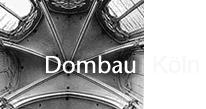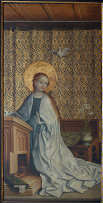Virgin’s head, shoulders and hand
The underdrawings of the outsides of the two wings are largely the same in extent, style and manner, so we can say that they probably are by the same hand. The typical characteristic is a freehand loose and apparently brisk drawing style. The form and plasticity of the figure of the Virgin and all the other motifs are fixed in detail in the drawing. The faces are drawn in detail with indications of ears, lips, noses, eyelids and irises. In the form taken by the strokes, with their rapid changes of direction, the Virgin’s hair, falling loosely over her shoulders in soft waves, exhibits the characteristics of a quill (Latin: ‘penna’) as drawing instrument.
In places, there are clear discrepancies between the underdrawing and painterly execution of the figure of the Virgin. Thus her head, her face and her hair are, in the drawing, far freer and looser in style. Her narrower face is more strongly inclined towards her left shoulder and her long wavy hair flows around the barely visible ear down to her shoulders. In contrast to the painted pearl headband, the underdrawing shows a hairband set with pearls and jewels, running to a flower-shaped rosette over her forehead. The composition of her torso has also undergone a change, for the cloak falling simply over her shoulders is still fastened in the underdrawing in the middle of her breast by a large bejewelled brooch (see red mapping lines). Only after a start had been made on painting the gown and cloak on the basis of the underdrawing was a decision taken to change the form, whereupon the new and finally realized form of the cloak was fixed with just a few new underdrawing strokes (see pale blue mapping lines). A (by comparison, trivial) change is also visible in the positions of the Virgin’s fingers and in the adjacent sleeve, which in the underdrawing was not close-fitting but fell loosely over the wrist.
projekt von:













